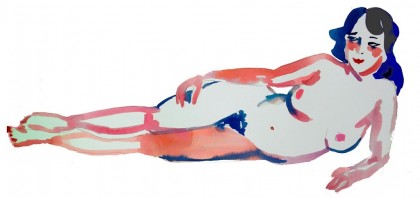 |
| Winslow Homer Studio, Prouts Neck, Maine |
The Portland Museum of Art is another of our favorite stops in Maine. Besides the impressive permanent collection which includes some 17,000 works of American and European fine and decorative art from the 18th through 21st centuries, we have seen some fantastic exhibitions in the summer months when we visit. This summer we very much enjoyed The William S. Paley Collection: A Taste for Modernism. Organized by MoMA, it features 61 works by modern masters such as Picasso, Matisse and Gauguin from this wonderful private collection. Paley, of course longtime president and chairman of CBS and husband of the legendarily stylish Babe, began assembling these works in the 1930s. The Portland Museum of Art is the only New England stop on the show’s 2012-2014 tour. On our wish list for next summer is a visit to Winslow Homer’s Studio. Acquired by the museum in 2006 and carefully restored since then, it opened to the public in September 2012. Homer lived and worked in the studio from 1883 until his death in 1910, painting many of his masterworks on the property. Now a National Historic Landmark, it is a true American treasure.
The William S. Paley Collection: A Taste for Modernism is on view until September 8. www.portlandmuseum.org
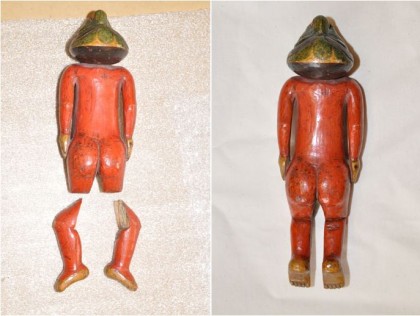 |
| Polychromed wood sculpture, Pacific NW Coast |
WHAT LED YOU TO BECOME AN ART CONSERVATOR AND WHAT DO YOU LOVE MOST ABOUT ART CONSERVATION?
When I was a kid I made meticulous drawings and paintings, and also loved science. I was pre-med as an undergraduate but majored in art history, while foraging a bit into architecture and fine art. Summer museum jobs with hands on experience–matting and hinging works on paper, doing condition reports for exhibitions, and installing artwork–really got me started. Also I had interesting experiences at the Dendrochronology Lab in the Classics/Archaeology Department at Cornell. They take core samples from ancient wood to measure tree growth rings to provide a dating method, accurate to the year, going back 10,000 years in the Aegean and Near East region, the cradle of so many civilizations. I studied art conservation and Italian in Florence for a year after college, completed some internships, and got into grad school at NYU Institute of Fine Arts, one of a handful of graduate programs for art conservation in the US. It was a thrill to be a conservator at archaeological sites in the Mediterranean for many summers during and after graduate school.
I love the gratification of making something whole, or legible, or returning a work to its original beauty. The best aspect of my job may be seeing the opportunity to save something thought to be utterly lost.
IT WOULD SEEM THAT ART CONSERVATION REQUIRES THE PERFECT BALANCE OF SCIENCE AND ART/CULTURAL HISTORY. IS THIS ACCURATE AND ARE YOU INCLINED MORE ONE WAY THAN ANOTHER?
Absolutely. Science, fine art/hand skills, and art history compliment each other in art conservation. At this point I do more hands on work than research…I guess that makes the artistic side more dominant, but also some degree of engineering is involved too.
THROUGHOUT YOUR CAREER YOU HAVE CONSERVED SOME MAJOR WORKS OF ART. DO YOU HAVE A SINGLE PIECE THAT YOU ARE MOST PROUD OF?
A few years ago I helped prepare for a show about Aphrodite that originated at the MFA Boston and traveled to Japan and the Getty Villa in California. With Aphrodite as the subject there was certainly beauty in the objects, and the glazed Greek and Roman ceramics were filled with great storytelling. I loved being around these objects and seeing how the curator developed her academic study using the wild narrative of this goddess of love and passion.
WHAT BRINGS YOU JOY?
I can’t wait to be on Mt. Desert Island, Maine in a few days. A perfect day includes a hike up the mountains where you get incredible 360° views of the islands and sea from the exposed granite ridges and summits, followed by a refreshing lake swim…there’s something magical about Echo Lake water. We’ve been going to MDI since our kids were very young, and the place has a history we add to and relive every year.
COMB OR BRUSH?
Fingers and comb.
DO YOU LIKE YOUR NAME?
You know, I guess I do! It’s good to have a relatively uncommon first name (despite Friendsand Bill Clinton). I changed my last name when I got married and Berry was initially hard to embrace, (my husband was not). Now I realize the alphabetical order advantage.
FINISH THIS SENTENCE: MY AGE IS…………….
…changing in October.
WHAT’S FOR DINNER TONIGHT?
Farmer’s market bounty! Tomatoes and basil, crisp cucumbers, sweet corn, roasted beets, melon…I think it’s time for lunch.
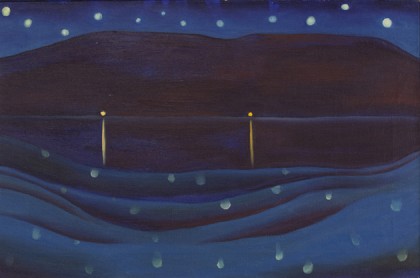 |
Georgia O’Keeffe (1887-1986), Starlight Night, Lake George, 1922
copyright Georgia O’Keeffe Museum/Artists Rights Society (ARS), New York |
It’s certainly true that Georgia O’Keeffe is best known for her depictions of flowers and the American southwest. But my favorite O’Keeffe works have always been her paintings of New York City and those painted at Lake George, the latter of which relatively few have been included in exhibitions over the years. That is until now. I just last week visited Modern Nature: Georgia O’Keeffe and Lake George at the Hyde Collection in upstate New York. The entire show, the first of its kind, focuses on the large body of work O’Keeffe created at her husband’s — the great American photographer Alfred Stieglitz — family compound. From 1918 until 1934, O’Keeffe spent several months each year at the 36-acre Adirondack Mountain property on which she had a studio of her own. Her time spent there quite clearly served as a tremendous source of inspiration. It is also believed to have been essential in the development of her signature, modern style of abtracting nature. I so was pleased to see this very nice article that appeared this past Sunday in The New York Times about this noteworthy exhibition. If you can’t make it to the Hyde before it closes on September 15, perhaps you can see it at the Georgia O’Keeffe Museum this fall/winter or the de Young Museum in San Francisco opening in February 2014.
www.hydecollection.org
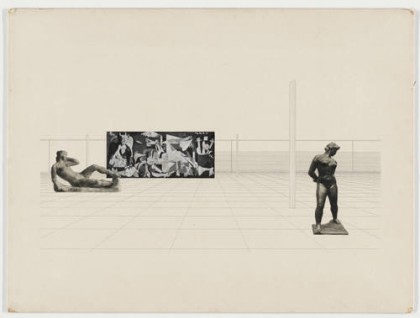 |
| Ludwig Mies van der Rohe, Museum for a Small City Project, Interior perspective, 1941-43, copyright 2013 Artists Rights Society (ARS), collection Museum of Modern Art |
A very nice exhibition opened last month at MoMA — Cut n’ Paste: From Architectural Assemblage to Collage City. The highlights for me were definitely the numerous Mies van der Rohe photocollages, so powerfully serene, so visionary and so great to see in person. I LOVE photocollage. Embraced by the Dadaists and the Surrealists, and clearly the most celebrated of architects, among so many others, this medium dates much further back than the early twentieth century. In fact, it dates to at least the Victorian era. In early 2010, I happened upon a truly fantastic and fantastical show at the Metropolitan Museum of Art entitled Playing with Pictures: The Art of Victorian Photocollage. Organized by the Art Institute of Chicago, it featured previously unknown photocollages from fifteen different albums created by aristocratic women, amateur artists, in 1860s and 70s England. These works are universally superb and without question paved the way for one of the most important and influential artistic and aesthetic traditions.
Cut n’ Paste: From Architectural Assemblage to Collage City is on view at MoMA through December 1, 2013.
Playing with Pictures: The Art of Victorian Photocollage by Elizabeth Siegel (The Art Institute of Chicago with Yale University Press, 2009)
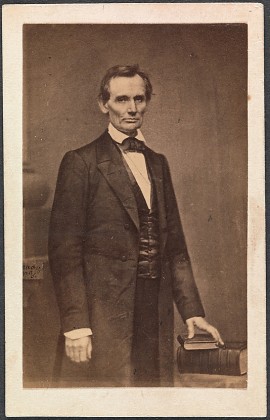 |
Abraham Lincoln, February 27, 1860
Photographed by Matthew B. Brady |
We went to the Metropolitan Museum of Art last week specifically to catch Punk: Chaos to Couture before it closes in a few weeks. Luckily we stayed a bit longer and wandered into Photography and the American Civil War — without question the standout exhibition for me that day. The portraiture in this show is tremendously powerful. The images of generals and soldiers and newly freed slaves, whose destinies at the time of their sitting were most uncertain, are quite haunting and so beautiful. The portraits of patients in a war hospital, documenting their injuries and treatments for teaching purposes (a seriously enlightened idea), are completely fascinating. And those soulful eyes of Abraham Lincoln…
Photography and the American Civil War is on view through September 2, 2013
www.metmuseum.org
WHAT LED YOU TO BECOME AN ILLUSTRATOR AND PAINTER AND WHAT DO YOU LOVE MOST ABOUT YOUR JOB?
If I had the type of mind that was really shrewd and clever about money or real estate or whatever, I would have been a banker or some kind of baller entrepreneur. As it is, I’m good with people and aesthetics, and I just needed to satisfy my curiosity, make a living, and burn off a sort of puritan work ethic I’ve always had in me. I just hustled toward the thing I felt best at, and it’s this. And I’m a pleaser, so it’s nice to make things for people and have them respond so graciously. Kind of like being a chef, but less essential.
WHO ARE YOUR FAVORITE ARTISTS AND WHOSE WORK ARE YOU MOST INSPIRED AND INFLUENCED BY?
I love portraits — Manet, Sargent, Whistler. I guess those guys would all be classified as ‘post-impressionists’. Hockney, for being such a wit and a workhorse. I have a weakness for bright pastels, Florida / California colors. I really loved the Cecily Brown show that was just at Gagosian uptown. But my favorite art, really, is TV. Comedy. I’m having a renaissance with the Simpsons, new episodes. It’s still incredible.
CUSTOM HERALDRY IS SUCH A LOVELY CONCEPT. WHAT IS YOUR PROCESS OF DEVELOPING SUCH A SPECIAL PIECE WITH A CLIENT?
Usually it’s a phone interview, but if they’re in New York I’ll meet with the couple, which I love. It’s just sweet to talk to people at this moment in their lives when they’re so in love and have a sense of beginning. I try my best to diffuse some of the stress and silliness of wedding planning and get at something pure.
WHAT BRINGS YOU JOY?
All the different faces, body types, ways of saying things. The goodness and funniness of people. Dogs. Laughing and talking trash with my husband and my friends. Walking around the city. Clothes.
COMB OR BRUSH?
Brush! Vigorously but not that often.
DO YOU LIKE YOUR NAME?
Yeah, I like it. I wonder sometimes what my life would be like if my name was, like, Jennifer Weintraub or something. I’m not one of those people who feels I was meant to be born in another era, on another continent. It all feels about right to me.
FINISH THIS SENTENCE: MY AGE IS…………….
33
WHAT’S FOR DINNER TONIGHT?
Probably rice and beans and avocado and tomato. I eat like I’m heading off to build a pyramid right after.
I recently saw Gilles Bourdos’ gorgeous new film Renoir. Set in the summer of 1915 at the great Impressionist painter’s farm on the French Riviera, Renoir is all about beauty, inspiration and naturally, the importance of an artistic life. Veteran French actor Michel Bouquet is sublime as the aging Renoir. And the cinematography of the genius Mark Lee Ping Bin (whose most recent work includes the exquisite Norwegian Wood) is breathtaking, fully capturing the rich palette and lushness of the Cote d’Azur and this artist’s world, so much so that you feel as if you are in a Pierre-Auguste Renoir painting itself. Certainly my idea of a perfect summer movie.
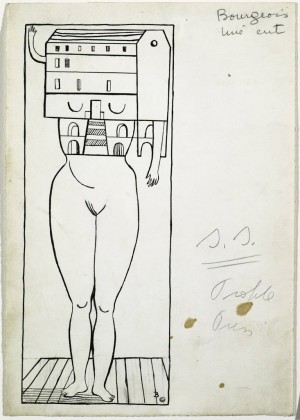 |
Louise Bourgeois, Femme Maison, 1947, Solomon R. Guggenheim Museum, New York
copyright The Estate of Louise Bourgeois |
I have forever loved this ink and pencil drawing by the great Louise Bourgeois. It speaks to me, very loudly, almost daily. I’m quite sure that the meaning and significance I place upon it is not at all what Bourgeois herself was thinking about when she created it. Isn’t one of the greatest gifts of art the power of interpretation?
We first discovered the work of Wanda Barcelona when walking past the W Hotel Union Square last month. In the window was an indescribably magnificent, huge paper and wood fan. Wanda Barcelona, the genius creator of the installation, is a Barcelona-based design firm that uses paper and cardboard, and the best of both traditional and new techniques, in all of their projects. Their work can be found all over the world and their client list is truly enviable. The W Hotel piece celebrated Spanish design, hence the fan, in conjunction with the 25th annual International Contemporary Furniture Fair (ICFF). The feathery part was composed of 6,000 tiny pieces of furniture, all paper, all assembled by hand. The artistry was sublime and certainly lived up to its name: FANtastico!
www.wandabarcelona.com
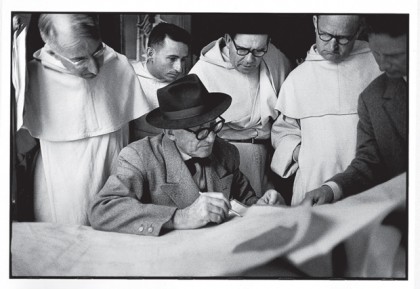 |
Le Corbusier at work on Sainte Marie de la Tourette, Eveux-Sur-Arbresle, 1959
Photograph by René Burri |
Over the weekend I attended the preview of Le Corbusier: An Atlas of Modern Landscapes at MoMA. As promised, this is a seriously comprehensive exhibition beginning with his early life and work in Switzerland and culminating with the last projects before his death in 1965 on the beach near his beloved cottage in Roquebrune-Cap-Martin on the French Riviera. I am a huge fan and it was a dream to see all of this work — including sketches, paintings, architectural models, plans and elevations and so on — organized chronologically in one space to get an even better sense of the evolution and process of one of the most important architects and designers of the twentieth century. Most intriguing for me were actually Le Corbusier’s many paintings, so evocative of the modern movement in the 1920s and 30s, and also his religious buildings. The latter because I didn’t know that aspect of his work as well and because I have always been fascinated with modernist-designed places of worship. These structures number three in total — Chapelle Notre Dame du Haut, Sainte Marie de la Tourette and Sainte Pierre de Firminy — all built in France. The last of which, Saint Pierre de Firminy, was just completed in 2006, more than 40 years after it was conceived. The church of Saint Pierre was finished under the direction of José Oubrerie, an architect who worked for Le Corbusier from 1957 to 1965, and who in fact helped in the design of the edifice from its very beginning during those years. Quite remarkable.
www.moma.org






